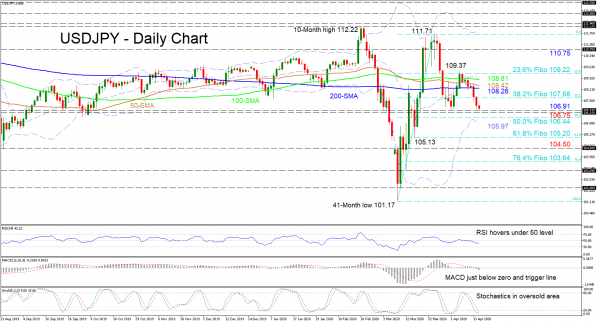USDJPY sellers are presently retesting the 106.91 latest low from April 1 after pivoting at the 109.22 level – that being the 23.6% Fibonacci retracement of the up leg from 101.17 to 111.71 – and pushing back under the mid-Bollinger band and congested simple moving averages (SMAs).
Reflecting a pause in the market are the short-term oscillators and the mostly flat SMAs. However, as things stand, it appears that the market is leaning slightly towards a neutral-to-bearish bias. The MACD has held below its red trigger line and has slipped below zero, while the RSI continues to hover in the bearish zone. Moreover, the stochastic %K and %D lines have yet to show signs of weakness to the downside.
A southwards penetration of the 106.91 – 106.75 support border could see the 50.0% Fibo of 106.44 underneath and lower Bollinger band around 105.97 come in defence against the decline. Extending past the lower band, the 61.8% Fibo of 105.20, near the 105.13 trough, could apply the brakes to a plunge towards the 104.50 support and 76.4% Fibo of 103.64.
Otherwise, if buyers re-emerge, the 38.2% Fibo of 107.68 could initially restrict the move up. Above that, a congested region of obstacles from the 200-day SMA of 108.26 to the mid-Bollinger band at 108.81 – including the other SMAs – could bring the climb to a halt. Successfully clearing this and breaking above the 23.6% Fibo of 109.22 and nearby 109.37 high, a rally lifting the price towards the 110.75 resistance could unfold.
Overall, the short-term picture leans towards a neutral-to-bearish bias and a close above 109.37 or below 106.75 could set the next directional course in action.













